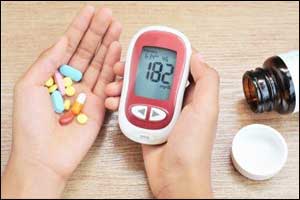- Home
- Editorial
- News
- Practice Guidelines
- Anesthesiology Guidelines
- Cancer Guidelines
- Cardiac Sciences Guidelines
- Critical Care Guidelines
- Dentistry Guidelines
- Dermatology Guidelines
- Diabetes and Endo Guidelines
- Diagnostics Guidelines
- ENT Guidelines
- Featured Practice Guidelines
- Gastroenterology Guidelines
- Geriatrics Guidelines
- Medicine Guidelines
- Nephrology Guidelines
- Neurosciences Guidelines
- Obs and Gynae Guidelines
- Ophthalmology Guidelines
- Orthopaedics Guidelines
- Paediatrics Guidelines
- Psychiatry Guidelines
- Pulmonology Guidelines
- Radiology Guidelines
- Surgery Guidelines
- Urology Guidelines
Vildagliptin, Metformin combo shows long term blood sugar control in newly diagnosed diabetics

Barcelona, Spain: Results from a recent Phase IV clinical study--VERIFY-- has shown better blood sugar control in patients who are on Early vildagliptin + metformin with newly detected type 2 diabetes. The findings were presented at the European Association for the Study of Diabetes (EASD) Annual Meeting and published simultaneously in The Lancet.
Diabetes mellitus is a condition characterized by high blood sugar due to defects in both insulin production and insulin sensitivity. There is a universal lack of achievement of blood sugar control, partly attributed to the current treatment paradigm involving sequential monotherapy, frequent early treatment failure and delayed therapy intensification leading to prolonged periods of sustained hyperglycemia. Prior studies have shown that combination drug therapy may curb this gap.
The study demonstrated that a combination of vildagliptin and metformin with complementary mechanisms of action provides superior efficacy and allows patients to reach glycemic targets without increasing the risk of hypoglycemia, weight gain and other CV risk factors. Vildagliptin-metformin combination was the first single-pill dual therapy of a DPP-4 inhibitor with metformin approved in Japan and Europe. The vildagliptin and metformin dual therapy is used when the patient’s T2DM is insufficiently controlled by metformin monotherapy.
Vildagliptin is approved as an oral treatment for adults with T2DM in more than 120 countries, including the EU, Japan, Latin America, and Asia-Pacific. Vildagliptin is approved for use as monotherapy, dual therapy in combination with metformin, sulfonylurea (SU) or a thiazolidinedione, as triple oral therapy in combination with a SU and metformin or as an add-on to insulin (with or without metformin). Vildagliptin is a selective and potent DPP-4 inhibitor that acts by preventing the usually rapid degradation of the incretin hormones such as glucagon-like peptide-1 (GLP-1) and glucose-dependent insulinotropic polypeptide (GIP), which in turn, enhances the alpha- and ß-cell sensitivity to glucose and inhibits glucagon secretion, thereby improving glycemic control in T2DM.
Metformin hydrochloride is widely used and is the recommended first-line therapy in patients with newly-diagnosed T2DM either immediately after diagnosis or in those not able to achieve glycemic targets despite diet and other lifestyle interventions[12].
Despite its discovery already in 1922, the exact mode of action for metformin is not yet known. However, its effect on the management of diabetes is through reduction of glucose output in the liver and secondarily, through the increase of glucose uptake in the peripheral tissues. However, recent data suggest that some clinical activity may also arise from the synthesis and stimulation of intestinal release of incretin hormones
Phase IV clinical study VERIFY was conducted to evaluate the long-term efficacy and safety of early combination treatment strategy with metformin plus vildagliptin (dipeptidyl peptidase-4 [DPP-4] inhibitor) compared to the traditional stepwise approach with metformin as initial therapy followed by vildagliptin, added at the time of metformin failure.
VERIFY is designed to determine durability, over a pre-specified five-year follow-up of early use of combination therapy strategy with vildagliptin-metformin. The study was conducted across 254 centers in 34 countries and involved 2001 treatment-naïve diverse individuals recently diagnosed with T2DM (HbA1c between 6.5–7.5% [48–58 mmol/mol]).
In the randomized, double-blind Phase IV study, early combination therapy of vildagliptin (50 mg, twice daily) and metformin (individually, 1000–2000 mg, daily) met the primary endpoint with a statistically significant 49% reduction in the relative risk for time to initial treatment failure (HbA1c >= 7.0% twice, consecutively, 13 weeks apart), versus metformin alone.
The combination treatment strategy also showed a lower frequency of secondary failure when all patients were receiving combination therapy. Furthermore, patients treated with early combination had consecutively lower HbA1c levels for 5 years versus those receiving combination therapy only after metformin monotherapy failure.
“The initial findings from the VERIFY study uniquely demonstrate that early intervention with a combination therapy strategy provides greater and durable long-term benefits for patients. The currently recommended initial monotherapy approach with later treatment intensification in type 2 diabetes management is now shown to be an inferior strategy,” said Professor David Matthews, EASD President and Emeritus Professor of Diabetic Medicine, University of Oxford, UK.
The overall safety and tolerability profile was similar between the treatment approaches, with no unexpected or new safety findings reported.
“Despite type 2 diabetes having become an epidemic with growing mortality and morbidity rates, there is a distinct lack of optimized management strategies at diagnosis that can induce durability and slow down disease progression,” said Marcia Kayath, Global Head Medical Affairs and Chief Medical Officer, Novartis Pharmaceuticals. “These promising results from the VERIFY study have the potential to improve patient outcomes and the way in which we treat type 2 diabetes in the future”.
Additional pre-defined secondary analyses of the VERIFY study results are ongoing and data will be disclosed over the coming months at international and local medical congresses and in scientific journals.

Disclaimer: This site is primarily intended for healthcare professionals. Any content/information on this website does not replace the advice of medical and/or health professionals and should not be construed as medical/diagnostic advice/endorsement or prescription. Use of this site is subject to our terms of use, privacy policy, advertisement policy. © 2020 Minerva Medical Treatment Pvt Ltd